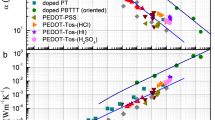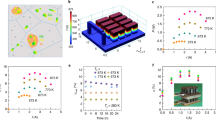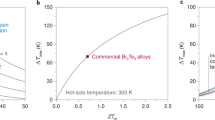Abstract
Thermoelectric generators (TEGs) transform a heat flow into electricity. Thermoelectric materials are being investigated for electricity production from waste heat (co-generation) and natural heat sources. For temperatures below 200 °C, the best commercially available inorganic semiconductors are bismuth telluride (Bi2Te3)-based alloys, which possess a figure of merit ZT close to one1. Most of the recently discovered thermoelectric materials with ZT>2 exhibit one common property, namely their low lattice thermal conductivities2,3. Nevertheless, a high ZT value is not enough to create a viable technology platform for energy harvesting. To generate electricity from large volumes of warm fluids, heat exchangers must be functionalized with TEGs. This requires thermoelectric materials that are readily synthesized, air stable, environmentally friendly and solution processable to create patterns on large areas. Here we show that conducting polymers might be capable of meeting these demands. The accurate control of the oxidation level in poly(3,4-ethylenedioxythiophene) (PEDOT) combined with its low intrinsic thermal conductivity (λ=0.37 W m−1 K−1) yields a ZT=0.25 at room temperature that approaches the values required for efficient devices.
This is a preview of subscription content, access via your institution
Access options
Subscribe to this journal
Receive 12 print issues and online access
$259.00 per year
only $21.58 per issue
Buy this article
- Purchase on Springer Link
- Instant access to full article PDF
Prices may be subject to local taxes which are calculated during checkout




Similar content being viewed by others
Change history
09 May 2011
In the version of this Letter originally published online, the y-axis values in Fig. 2c were incorrect by 10-2. Hence in the discussion of this figure in the text, the maximum power output after 10 min TDAE exposure for a load resistance of 39 Ω should have read 1.13 nW. Both these errors have now been corrected in the HTML and PDF versions.
References
Goldsmid, H. J. Recent Trends in Thermoelectric Materials, Semiconductors and Semimetals Vol. 69, Ch.1 (Academic, 2000).
Snyder, G. J. & Toberer, E. S. Complex thermoelectric materials. Nature Mater. 7, 105–114 (2008).
Venkatasubramanian, R., Siivola, E., Colpitts, T. & O’Quinn, B. Thin-film thermoelectric devices with high room-temperature figures of merit. Nature 413, 597–602 (2001).
Yan, H., Sada, N. & Toshima, N. Thermal transporting properties of electrically conductive polyaniline films as organic thermoelectric materials. J. Therm. Anal. Calorim. 69, 881–887 (2002).
Feng-Xing, J. et al. Thermoelectric performance of Poly(3,4-ethylenedioxythiophene): Poly(styrenesulfonate). Chin. Phys. Lett. 6, 2202–2205 (2008).
Moses, D. & Denenstein, A. Experimental determination of the thermal conductivity of a conducting polymer: Pure and heavily doped polyacetylene. Phys. Rev. B 30, 2090–2097 (1884).
Cahill, D. G. Thermal conductivity of amorphous solids above the plateau. Phys. Rev. B 35, 4067–4073 (1987).
Jun, L., Zhang, L-M., He, L. & Tang, X-F. Synthesis and thermoelectric properties of polyaniline. J. Wuhan Univ. Technol.-Mater. Sci. Ed. 18, 53–55 (2008).
Kemp, N. T. et al. Thermoelectric power and conductivity of different types of polypyrrole. J. Polym. Sci. B 37, 953–960 (1999).
Aïch, R. B., Blouin, N., Bouchard, A. & Leclerc, M. Electrical and thermoelectric properties of poly(2,7-carbazole) derivatives. Chem. Mater. 21, 751–757 (2009).
Groenendaal, L., Jonas, F., Freitag, D., Pielartzik, H. & Reynolds, J. R. Poly(3,4-ethylenedioxythiophene) and its derivatives: Past, present, and future. Adv. Mater. 12, 481–494 (2000).
Crispin, X. et al. Conductivity, morphology, interfacial chemistry and stability of poly(3,4-ethylene dioxythiophene)—poly(styrene sulfonate): A photoelectron spectroscopy study. J. Polym. Sci. B 41, 2561–2583 (2003).
Winther-Jensen, B. & West, K. Vapor-phase polymerization of 3,4-ethylenedioxythiophene: A route to highly conducting polymer surface layers. Macromolecules 37, 4538–4543 (2004).
Aasmundtveit, K. E. et al. Structure of thin films of poly(3,4-ethylenedioxythiophene). Synth. Met. 101, 561–564 (1999).
Lindell, L. et al. Transparent plastic low-workfunction poly(3,4-ethylenedioxythiophene) electrodes. Chem. Mater. 18, 4246–4252 (2006).
Winther-Jensen, B., Winther-Jensen, O., Forsyth, M. & MacFarlane, D. R. High rates of oxygen reduction over a vapor phase-polymerized PEDOT electrode. Science 321, 671–674 (2008).
Koh, Y. K. & Cahill, D. G. Frequency dependence of the thermal conductivity of semiconductor alloys. J. Appl. Phys. 105, 054303 (2009).
Losego, M. D., Moh, L., Arpin, K. A., Cahill, D. G. & Braun, P. V. Interfacial thermal conductance in spun-cast polymer films and polymer brushes. Appl. Phys. Lett. 97, 011908 (2010).
Borca-Tasciuc, T., Kumar, A. R. & Chen, G. Data reduction in 3ω method for thin-film thermal conductivity determination. Rev. Sci. Instrum. 72, 2139–2147 (2001).
Chaikin, P. M., Kwak, J. F., Jones, T. E., Garito, A. F. & Heeger, A. J. Thermoelectric power of tetrathiofulvalinium tetracyanoquinodimethane. Phys. Rev. Lett. 31, 601–604 (1973).
Böttner, H., Nurnus, J. & Schubert, A. Thermoelectrics Handbook: Macro to Nano Ch. 46-13 (CRC, 2006).
Wusten, J. & Potje-Kamloth, K. Organic thermogenerators for energy autarkic systems on flexible substrates. J. Phys. D 41, 135113 (2008).
Acknowledgements
The authors wish to thank the Swedish Energy Agency, the Swedish Government (Advanced Functional Materials) and the Knut and Alice Wallenberg Foundation for financial funding for this project. M.F. and S.B. thank the Swedish Research Council for financial support. M.B. wishes to thank the Önnesjö Foundation for financial support. We also want to thank D. Emin and D. Cahill for fruitful scientific discussions and B. Sklepkovych for comments regarding an earlier draft.
Author information
Authors and Affiliations
Contributions
X.C. and A.M. initiated the study. O.B. performed the conductivity and thermopower measurements and fabricated the thermogenerators. Z.U.K. developed the 3ω -technique to measure the thermal conductivity. S.B. and M.F. performed the photoelectron spectroscopy measurements. O.B., Z.U.K. and X.C. prepared the manuscript. X.C. and M.B. coordinated the project. All authors revised and approved the manuscript.
Corresponding author
Ethics declarations
Competing interests
The authors declare no competing financial interests.
Supplementary information
Supplementary Information
Supplementary Information (PDF 1312 kb)
Rights and permissions
About this article
Cite this article
Bubnova, O., Khan, Z., Malti, A. et al. Optimization of the thermoelectric figure of merit in the conducting polymer poly(3,4-ethylenedioxythiophene). Nature Mater 10, 429–433 (2011). https://doi.org/10.1038/nmat3012
Received:
Accepted:
Published:
Issue Date:
DOI: https://doi.org/10.1038/nmat3012
This article is cited by
-
Understand the Temperature Sensing Behavior of Solid-state Polymerized PEDOT Hybrid Based on X-ray Scattering Studies
Chinese Journal of Polymer Science (2024)
-
Heterogeneous Oriented Structure model of thermoelectric transport in conducting polymers
Scientific Reports (2023)
-
Highly conductive tissue-like hydrogel interface through template-directed assembly
Nature Communications (2023)
-
Ultrafast-laser-treated poly(3,4-ethylenedioxythiophene): poly(styrenesulfonate) electrodes with enhanced conductivity and transparency for semitransparent perovskite solar cells
Frontiers of Chemical Science and Engineering (2023)
-
Oxidative Molecular Layer Deposition Tailoring Eco-Mimetic Nanoarchitecture to Manipulate Electromagnetic Attenuation and Self-Powered Energy Conversion
Nano-Micro Letters (2023)



